
Top Things to Do in the Westman Islands (Vestmannaeyjar)

- The Top 8 Things to Do in the Westman Islands
- 8. Visit Herjolfstown in Herjolfsdalur
- 7. Visit the Stave Church
- 6. Explore the Heimaey Island
- 5. Visit the Beluga Whale Sanctuary and Puffin Rescue Center
- 4. Hike the Eldfell Volcano
- 3. Visit the Eldheimar Museum
- 2. See the World's Largest Puffin Colony
- 1. Explore the Westman Islands By Boat
- What to Know About Going to the Westman Islands
- How to Get to the Westman Islands
- The Best Time to Visit the Westman Islands
- Where to Stay in the Westman Islands
- What to Pack For the Westman Islands
- The Many Islands of the Vestmannaeyjar Archipelago
- History of the Westman Islands
- Settlement of The Westman Islands
- The Turkish Abductions of 1627
- The Eldfell Eruption of 1973
- Traditions in the Westman Islands
- Thjodhatid
- Goslokahatid
- Puffin Hunting and Egg Picking
- The Puffling Patrol
- Spranga - Cliff Swinging
- Summary of the Westman Islands
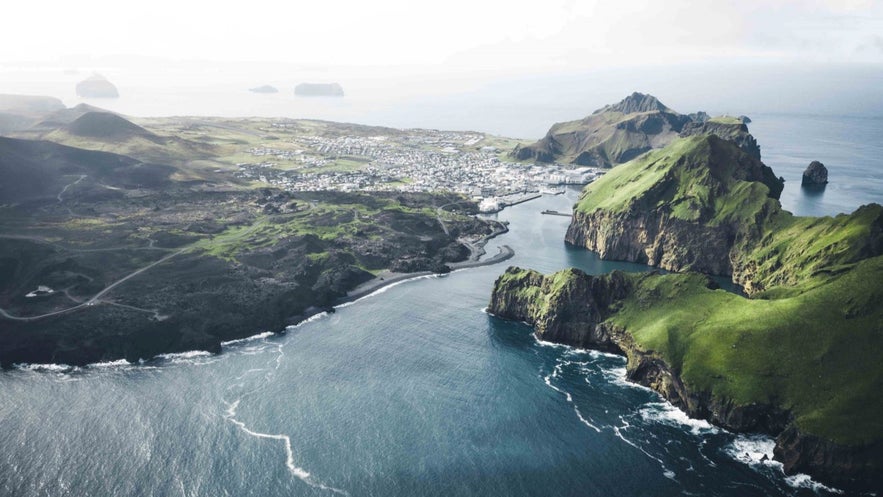
The Westman Islands, or Vestmannaeyjar in Icelandic, are a beautiful archipelago that is often overlooked by international visitors. They were formed by underwater volcanic activity, which is showcased by their striking landscapes, rugged cliffs, and grassy hills.
Of the island cluster, the main one is Heimaey, or "Home Island," where you'll find the charming town of Vestmannaeyjabaer, with around 4.500 inhabitants. It's the only habituated island in the archipelago, and there, you'll find all the necessary services, unique attractions and activities, and a great restaurant scene.
With many accommodation options in the Westman Islands, it makes for a unique and memorable experience as part of your Iceland trip.
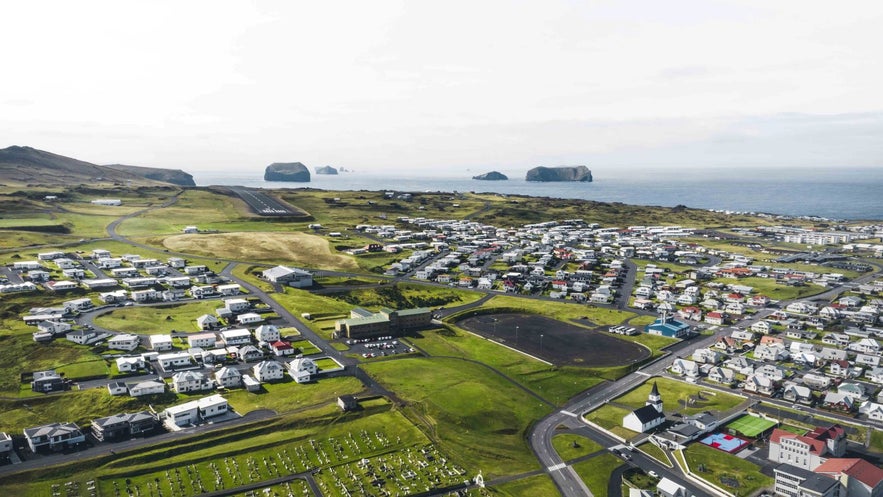 The Westman Islands are the best place to witness the effects of the volcanic forces in Iceland, as the most recent eruption of 1973 re-shaped the island of Heimaey and left deep marks on the town.
The Westman Islands are the best place to witness the effects of the volcanic forces in Iceland, as the most recent eruption of 1973 re-shaped the island of Heimaey and left deep marks on the town.
Additionally, the islands of Vestmannaeyjar are a haven for birdlife. They host the world's largest puffin colony, and their rugged cliffs are a sanctuary for numerous other species of seabirds. You can discover the magic of this archipelago by booking Westman Islands tours and exploring what it has to offer.
You'll find many attractions on the island, and while you can move between locations on foot, it's most convenient to bring your rental car with you when visiting. Alternatively, a bike would also be a good choice.
This will help you use your time more effectively and let you rather spend your energy exploring attractions and scenic locations, such as the internet-famous Elephant Rock. Read on to learn everything you need to know about visiting this charming archipelago.
The Top 8 Things to Do in the Westman Islands
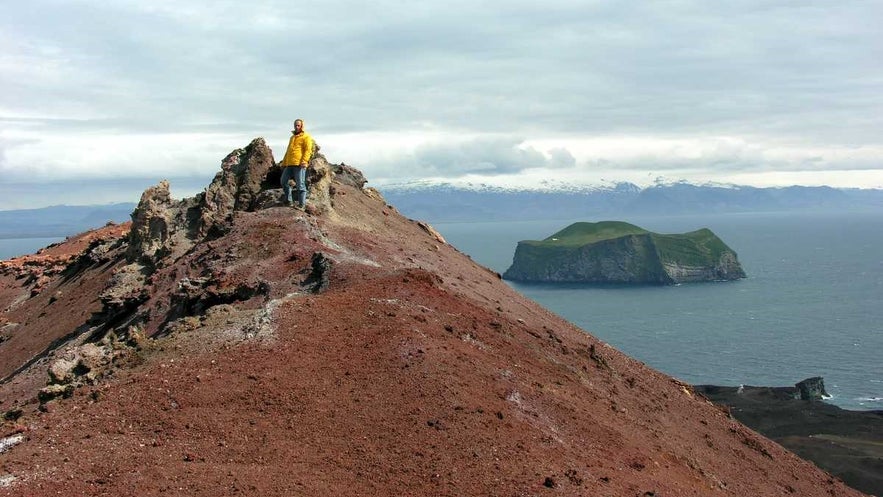
Photo from Wikimedia, Creative Commons, by Hansueli Krapf.
While the Vestmannaeyjar archipelago is best known for its volcanic beauty, you'll find plenty of varied activities for your visit. From stunning nature, historical locations, cultural attractions, and exciting tours, here are the top 8 things to do while in the Westman Islands.
8. Visit Herjolfstown in Herjolfsdalur
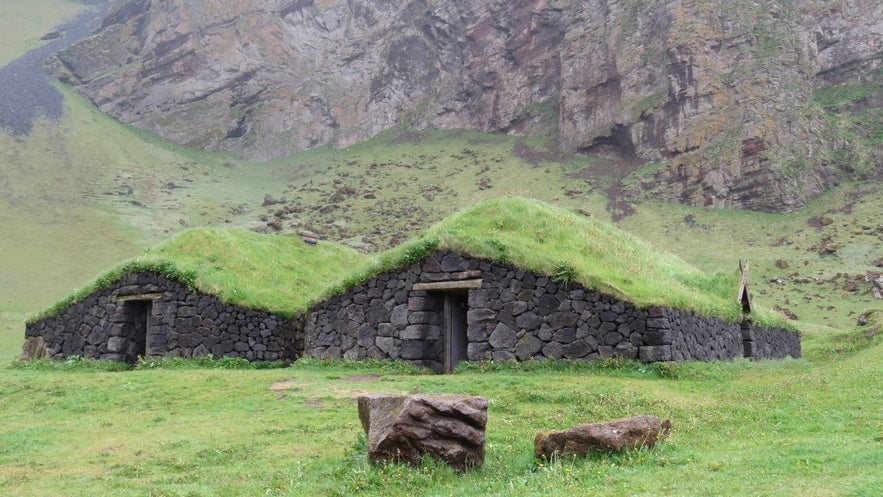
Photo from Herjolfsbaer.
Herjolfsdalur is a historical and scenic valley that holds great cultural significance for the local population. At the heart of the valley lies Herjolfstown, a replica of a Viking house that's said to be the home of the island's first Norse settler, Herjólfur Bárðarson.
Visiting Herjolfsbaer offers a unique opportunity to delve into the history of the Westman Islands. Inside, you'll get a glimpse into what daily life looked like for early settlers, complete with wax figures of Herjólfur and his family. During your visit, you'll have a guide who will share the story of the household, giving you insight into this historical time.
The Viking house is also surrounded by lush greenery and dramatic cliffs of Herjolfsdalur valley, and there are many great photo opportunities in this serene setting. Additionally, the valley is the venue of Thjodhatid, the biggest outdoor festival in Iceland, and it's where you'll find the island's most popular campsite.
- See more: The Top 20 Festivals in Iceland
7. Visit the Stave Church
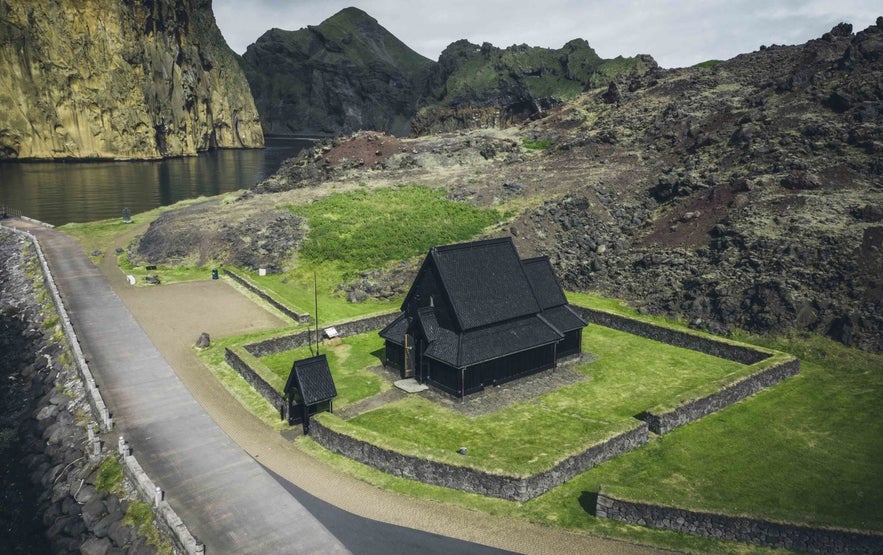 One building worth visiting is the Stave Church, which was gifted to Iceland by Norway in 2000, marking the millennium of Christianity in Iceland. Constructed entirely of wood, the church is a perfect example of a 'stave' church - a medieval Christian church architecture common in Norway.
One building worth visiting is the Stave Church, which was gifted to Iceland by Norway in 2000, marking the millennium of Christianity in Iceland. Constructed entirely of wood, the church is a perfect example of a 'stave' church - a medieval Christian church architecture common in Norway.
The building is unique in Iceland, and its' distinctive shape, dark wood exterior, and peaceful surroundings make it a truly beautiful place to visit. It stands as a symbol of the strong historical ties between Norway and Iceland and the profound influence of Christianity on Icelandic culture.
It's located by Skansinn, an old coastal fortification originally built in 1586. It has changed through the centuries, and today, it makes for a lovely walking area with great views of the surrounding cliffs.
Nearby, you'll also find the charming Landlyst Museum, located in one of the oldest houses in the Westman Islands. It was built in 1848 and housed Iceland's first birthing center, and today, you can visit an exhibition about the medical history of the country.
6. Explore the Heimaey Island
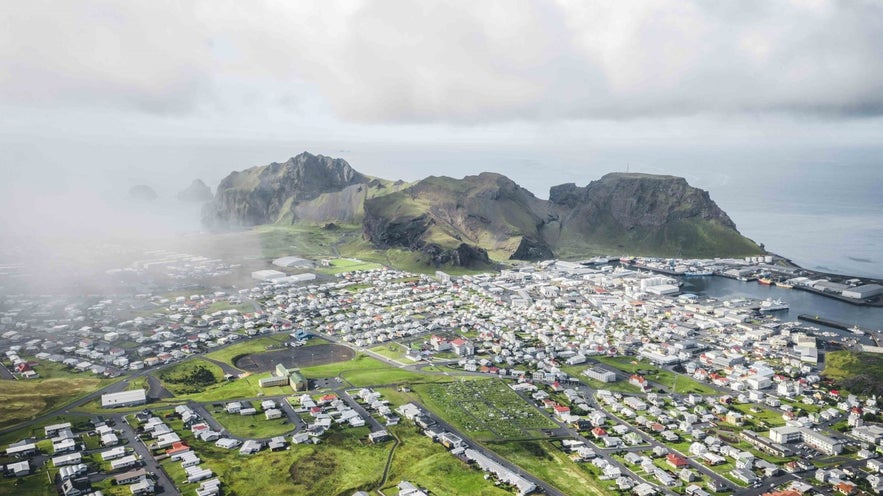 Heimaey is the largest island in the Vestmannaeyjar archipelago and the only one to be permanently habituated. While there, you can explore the Vestmannaeyjabaer's charming streets, visit local shops and attractions, and try different cafés and restaurants. One of the best things to do while there, however, is to explore the island itself.
Heimaey is the largest island in the Vestmannaeyjar archipelago and the only one to be permanently habituated. While there, you can explore the Vestmannaeyjabaer's charming streets, visit local shops and attractions, and try different cafés and restaurants. One of the best things to do while there, however, is to explore the island itself.
On Heimaey, you'll see diverse landscapes bustling with vivid birdlife. From high up, you'll see the surrounding islands, and on clear days, you can see see the mainland coast. There are also many hiking paths to choose from that range in difficulty.
One of the best paths to take is the Storhofdi route, an easy path that takes you to the southernmost point of Heimaey. Walking this path, you'll have fantastic views of the surrounding islands and the sea. You may even be able to spot puffins along the cliffs from the puffin viewing hut.
 The Heimaey Circle is another intriguing path. As the name suggests, this route encompasses the entire island, offering a comprehensive exploration of its diverse landscapes and offering opportunities to spot puffins in summer. It is also the path of the Puffin Run, a yearly race that usually takes place in May.
The Heimaey Circle is another intriguing path. As the name suggests, this route encompasses the entire island, offering a comprehensive exploration of its diverse landscapes and offering opportunities to spot puffins in summer. It is also the path of the Puffin Run, a yearly race that usually takes place in May.
Some paths will also bring you to significant locations in the history of the island. One such option is the "Path of the Turkish Abductions," which retraces the events of a horrific 17th-century raid by Barbary pirates which abducted around 292 islanders to be sold in slave auctions. Walking this path is an opportunity to learn more about this terrifying event in the island's history while enjoying the sights.
Whether you're an avid hiker or a casual walker, Heimaey will undoubtedly leave a lasting impression. You can find even more hiking paths around the island on the Vestmanneyjabaer website, along with further detailed information.
5. Visit the Beluga Whale Sanctuary and Puffin Rescue Center
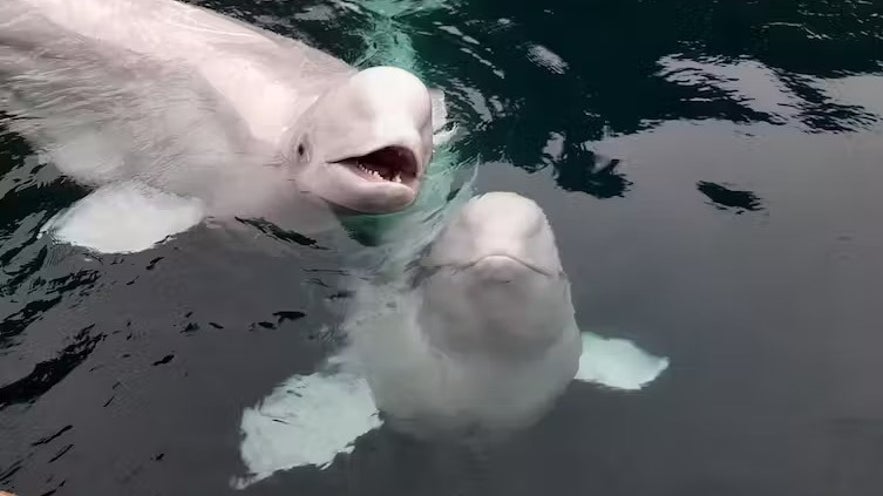
Photo from the Guided 45-Minute Tour of Beluga Whale Sanctuary and Puffin Rescue in Westman Islands.
The Beluga Whale Sanctuary in the Westman Islands is a groundbreaking project run by the Sea Life Trust that offers a new and more natural home for previously captive beluga whales. They also run the only Puffin Rescue Center in Iceland, located in the same building.
The sanctuary provides a home for two beluga whales, Little White, and Little Grey, who were relocated from a marine park in Shanghai. Currently, they are in a temporary indoor facility instead of their sea pen in Klettsvik bay. This is because the area is being cleaned up after a 2022 boat sinking that spread oil and fuel in the area.
Once the area is cleaned and ready, the whales will start their acclimation to the ocean, which will allow them to thrive in a more natural habitat. The Klettsvik bay area is also large enough to help more whales in the future. It was originally built as a rehabilitation zone for the killer whale Keiko, the star of the popular Free Willie movies, who was originally caught in Iceland in 1979 and brought back to his home country after his film career.
At the Visitor Center, you'll find interactive educational exhibits about belugas and the threats they face in the wild, along with a native species aquarium. There, you can also find the Puffin Rescue Center, which helps take care of puffins and pufflings (baby puffins) that are in need of rehabilitation or that can't survive on their own in the wild.
When you book a tour of Beluga Whale Sanctuary and Puffin Rescue, you'll get to see the facilities and hear about the work being done. You'll meet the animals and support a project that emphasizes respect and care for marine life. This makes the Beluga Whale Sanctuary a must-visit for animal lovers and conservation advocates.
The sanctuary is open to visitors from April to October, though the exact opening time can change per year. You can find detailed information on the Sea Life Trust website, and you can also donate to the project if you want to provide additional support.
If you're interested in the natural marine life of Iceland, you can also embark on a whale-watching tour from many places around the country. You may be able to spot minke whales, white-peaked dolphins, or even humpbacks!
- Learn more: The Best Guide to Whale Watching in Iceland
4. Hike the Eldfell Volcano

The Eldfell volcano is in the center of the photo, with Helgafell to the right and Bjarnarey Island to the left.
The Eldfell volcano, situated on Heimaey Island, holds a significant place in the island's history and landscape. The volcano erupted unexpectedly in 1973, causing a mass evacuation and dramatically altering the island's geography. Today, Eldfell stands as a stunning testament to the raw power of nature and the resilience of the island's inhabitants.
Hiking to the top of Eldfell is an unforgettable experience that's well worth the effort. The trail is well-marked and moderately easy, suitable for hikers of most fitness levels. As you ascend, you'll traverse the volcano's red gravel surface, a striking reminder of its fiery birth.
Reaching the summit, you're rewarded with panoramic views of the entire archipelago, the mainland, and the surrounding sea, offering a fantastic opportunity for photography. Furthermore, the ground at the top is still warm, a direct connection to the island's volcanic activity.
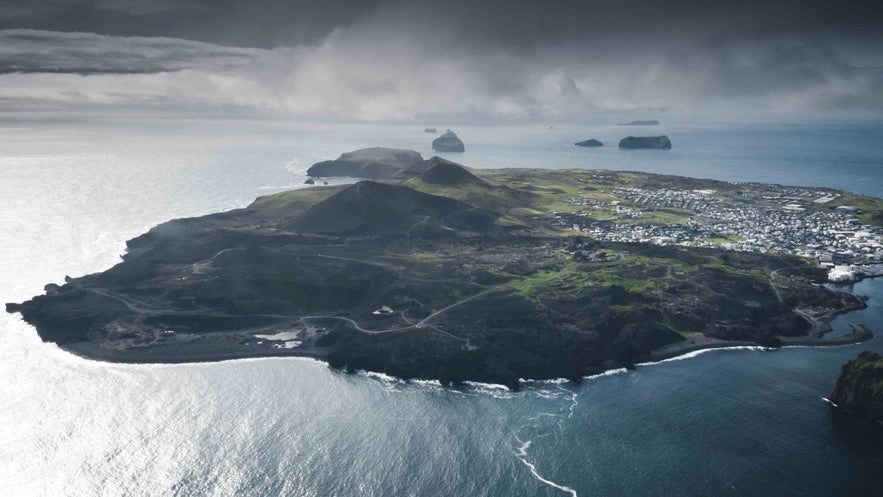 When in the area, take the opportunity to explore the new lava field from the 1973 eruption, especially as you can clearly see where the lava flow stopped on the edge of town. There is an established, family-friendly hiking path through the field, so the journey is quite easy.
When in the area, take the opportunity to explore the new lava field from the 1973 eruption, especially as you can clearly see where the lava flow stopped on the edge of town. There is an established, family-friendly hiking path through the field, so the journey is quite easy.
Less than two miles away, you'll see the Helgafell volcano, which erupted over 5000 years ago. It formed Heimaey Island as it's known today, and you can take a scenic hike to the top for great views of the island.
If you don't want to hike or simply want to add some thrill and excitement to your trip, you can explore the area with this exhilarating 1 hour ATV volcano tour, where you'll see all the major sights with a helpful guide.
- See more: Volcanic Eruptions in Iceland: A History of Fire
- See also: Iceland's Volcanoes: The Complete Guide
3. Visit the Eldheimar Museum
 The Eldheimar Museum is a poignant testament to the biggest natural disaster in Iceland’s recent history, the 1973 eruption of the Eldfell volcano. The eruption led to the evacuation of the entire population of the Westman Islands and caused significant damage.
The Eldheimar Museum is a poignant testament to the biggest natural disaster in Iceland’s recent history, the 1973 eruption of the Eldfell volcano. The eruption led to the evacuation of the entire population of the Westman Islands and caused significant damage.
The Eldheimar Museum, literally meaning "worlds of fire," is located on the site of a house that was buried under volcanic ash. As you walk through the museum, you'll be transported back to that fateful day through multimedia displays, personal accounts, and preserved remnants. At the center is the preserved home, partially excavated, offering a striking vision of the impact of the eruption.
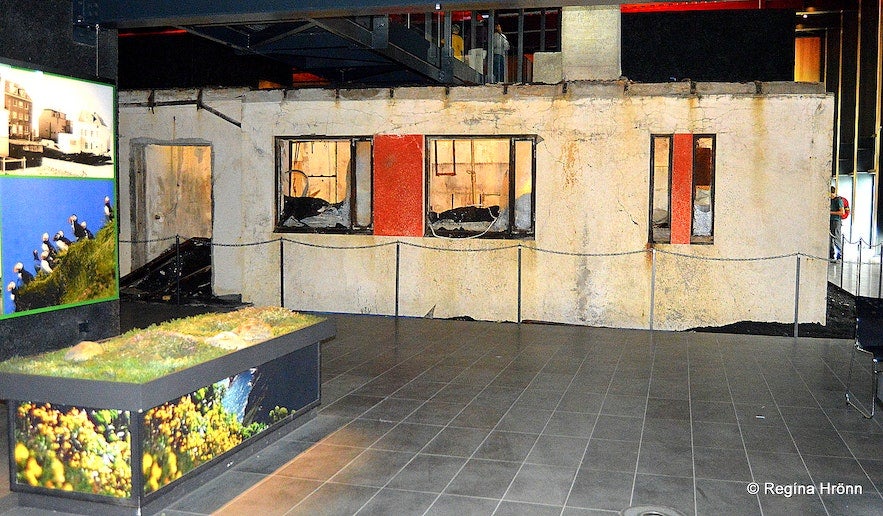
Photo from Regína Hrönn.
You'll also find a part dedicated to the Surtsey eruption of 1963, where a new island was created off the coast of Heimaey. The island is now a UNESCO World Heritage Site and is only accessible to scientists studying its natural changes and progression. You can, however, see it from a distance from Heimaey Island or during a boat tour.
Eldheimar provides a unique insight into the power of nature and the resilience of the human spirit. Visiting Eldheimar changes how you view the volcanic surroundings that are so prominent on the island and should not be missed when visiting Vestmannaeyjar.
2. See the World's Largest Puffin Colony
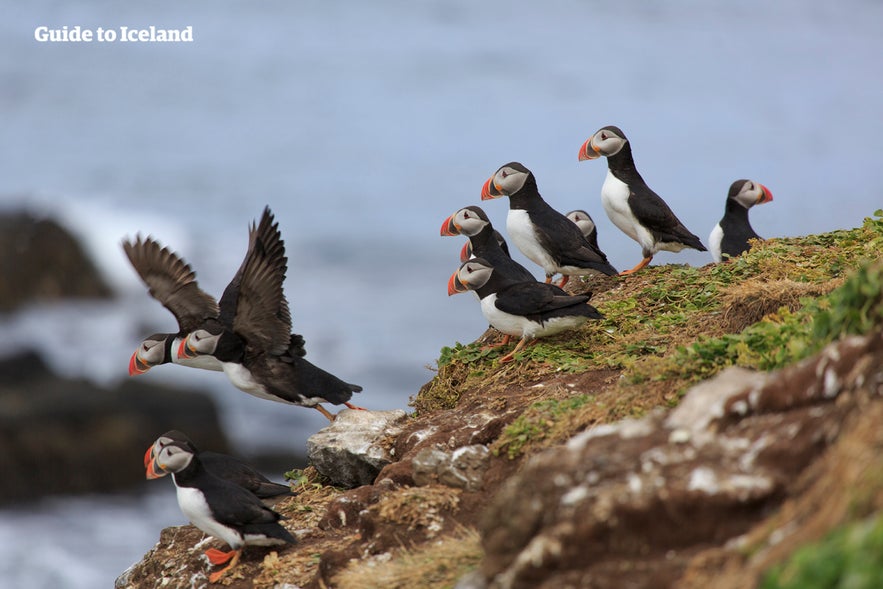 The Westman Islands are world-renowned for their puffin colonies, housing the largest population of nesting puffins in the world during the summer months. These adorable, black-and-white seabirds, with their distinctive large, colorful beaks, are an iconic symbol of Icelandic wildlife and draw visitors from all around the world.
The Westman Islands are world-renowned for their puffin colonies, housing the largest population of nesting puffins in the world during the summer months. These adorable, black-and-white seabirds, with their distinctive large, colorful beaks, are an iconic symbol of Icelandic wildlife and draw visitors from all around the world.
Visiting the Vestmannaeyjar archipelago offers an unparalleled opportunity to observe these charismatic birds up close in their natural habitat. During the breeding season from April to August, the cliffs of the islands are teeming with puffins, and you can watch as they go about their daily activities, from foraging for food to tending to their chicks.
As the birds mostly nest in the cliffs, the best way to see them is by boat, so if you want a close-up look, it's best done with a puffin tour. They offer a respectful and safe viewing of the puffins while providing the best experience possible.
You'll be able to see puffins as part of many island boat tours, but you can also have a more unique experience with this beautiful 2-hour puffin-watching tour with kayaks. You'll glide through the water among the island cliffs, visit scenic locations, and be able to see the little puffins on the way.

If you prefer to skip the tour, you can also see them from a distance on Heimaey island. A popular place to see them is the designated puffin viewing hut at the Storhofdi peninsula, also known as "the Great Cape." The hut was designed to minimize disturbance to the birds while letting you see them from a short distance. We recommend bringing good binoculars or a good zoom lens for your camera for close-up shots.
No matter how you want to go about it, seeing the nesting puffins is one of the highlights of any summer visit to the Westman Islands.
- See also: Where to See Puffins in Iceland
1. Explore the Westman Islands By Boat
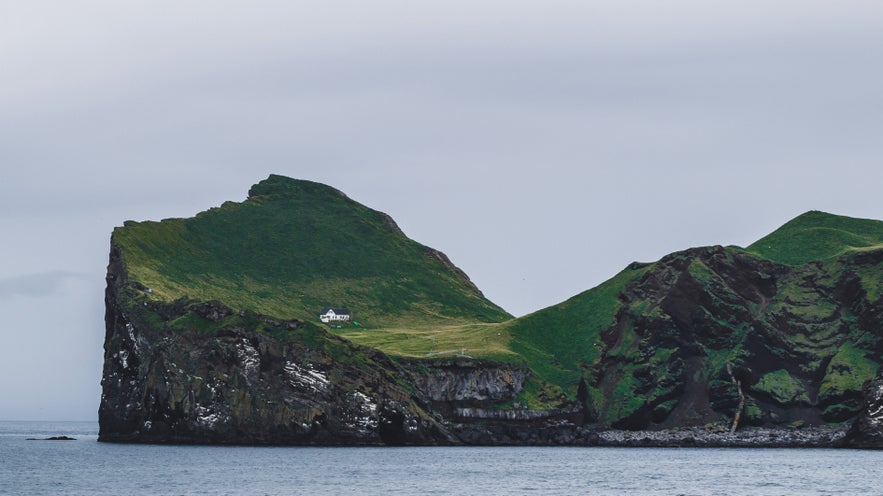
Ellidaey Island is famous for its dramatic cliffs and lonely house.
The Vestmannaeyjar archipelago features many small islands, skerries, dramatic cliffs, and rock formations rising up from the ocean, many of which can't be seen from land. This makes taking a boat tour of the Westman Islands one of the experiences that you should include on your itinerary.
Traveling by boat, you'll be able to see the charm of the surrounding islands. In the distance, you may spot Surtsey, the newest island in the archipelago, born out of a volcanic eruption in 1963. In fact, it's the youngest island on all of Earth! Although landing is prohibited to preserve its untouched ecosystem, seeing Surtsey from a distance is a thrilling reminder of the archipelago's volcanic origin. You can also learn more about it and its creation at the Eldheimar Museum.
As you glide through the waters, you'll explore the largest island, Heimaey. Its impressive cliffs, sculpted by the forces of nature, house millions of birds, including puffins, guillemots, and kittiwakes, making it a paradise for birdwatchers. Additionally, you may spot caves among the island cliffs, the most popular of which is Klettshellir.
One of the most famous locations you can see is the Elephant Rock formation at the northwest edge of Heimaey. The formation is entirely natural and looks like an elephant dipping its trunk into the ocean. It's composed of basalt, which gives the "elephant" the appearance of wrinkly skin and, therefore, makes it look more life-like.
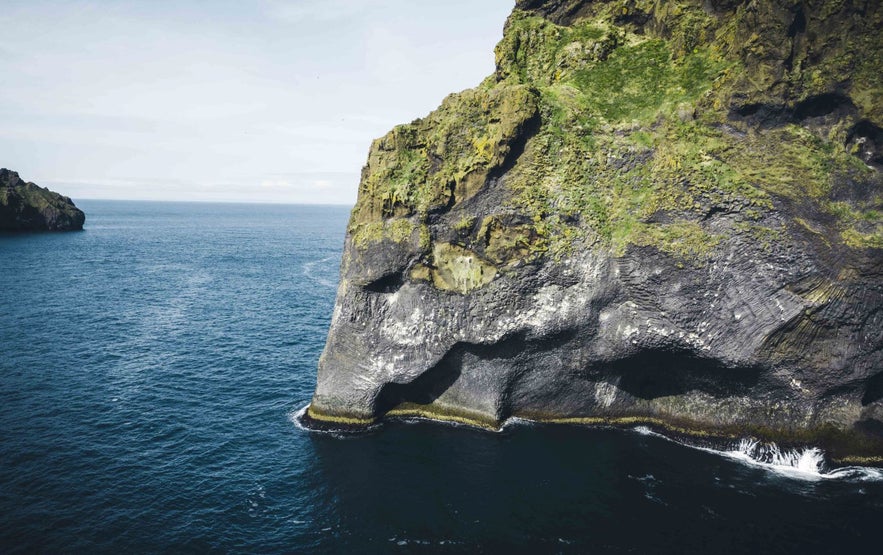
You can find different types of tours of the Vestmannaeyjar archipelago, so make sure to check which locations each one will visit before booking. For example, you can take this scenic 1-hour small island boat tour from Heimaey Harbor to see Elephant Rock, Klettshellir, the cliffs of Heimaey, and more.
The same applies to this 2-hour RIB boat tour of the Westman Islands, but you'll also be able to see more of the islands and rock formations with the longer run time.
No matter which one you choose, you'll be able to experience the natural splendor of the Westman Islands. It's an unforgettable adventure that has a place on any Westman Islands itinerary. Make sure to book your tour ahead of time when planning your trip to make sure you don't miss it.
What to Know About Going to the Westman Islands
When planning a visit to the Vestmannaeyjar islands, there are a few things to keep in mind. Here are some things to be aware of before going.
How to Get to the Westman Islands
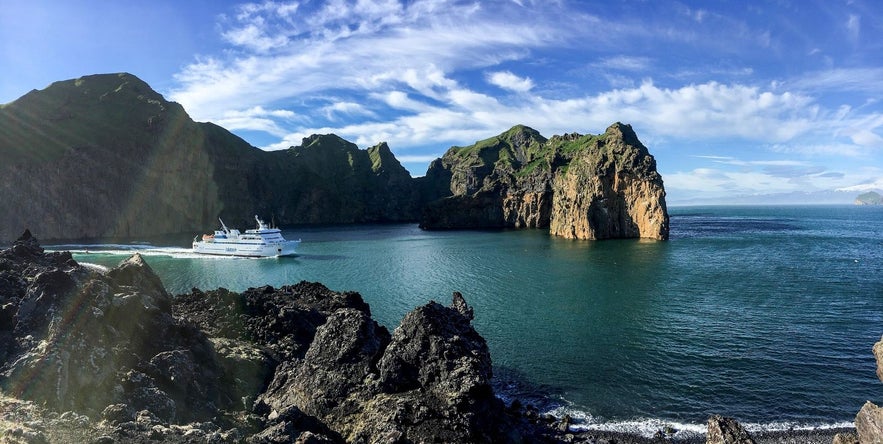
Photo from Wikimedia, Creative Commons, by Michał Strzelecki.
The most common way to get to the Westman Islands is by booking the Herjolfur ferry, as you can easily take your rental car with you to the island. It generally operates from the Landeyjahofn harbor on the South Coast, close to the Seljarlandsfoss waterfall. It's an approximately two-hour drive from Reykjavik, and the ferry ride itself takes around 35 minutes to reach the main island of Heimaey. You can find the Herjolfur schedule and the pricelist on the ferry website.
In the winter months or during rough weather, when the ferry cannot dock at Landeyjahofn, it departs from the harbor at Thorlakshofn, resulting in a slightly longer boat journey of about three hours. However, the drive from Reykjavik to Thorlakshofn takes just under an hour.
Alternatively, you can take a flight to the Westman Islands from Reykjavik Domestic Airport. The flight takes around 25 minutes, offering an aerial view of Iceland's dramatic landscape. However, please note that flight schedules can be affected by weather conditions.
One of the most convenient ways to visit if you don't have a rental car is with a guided tour of the Westman Islands. It's a great way to maximize your experience. You can find tour operators that will pick you up from your accommodation in Reykjavik and bring you to the islands and back, like with this guided 12.5-hour tour of the Westman Islands.
Both methods of travel provide their unique experiences - whether you enjoy the scenic drive and ferry ride, the short flight, or the hassle-free experience of a tour. Once there, the natural beauty and rich wildlife of the Westman Islands await you.
The Best Time to Visit the Westman Islands
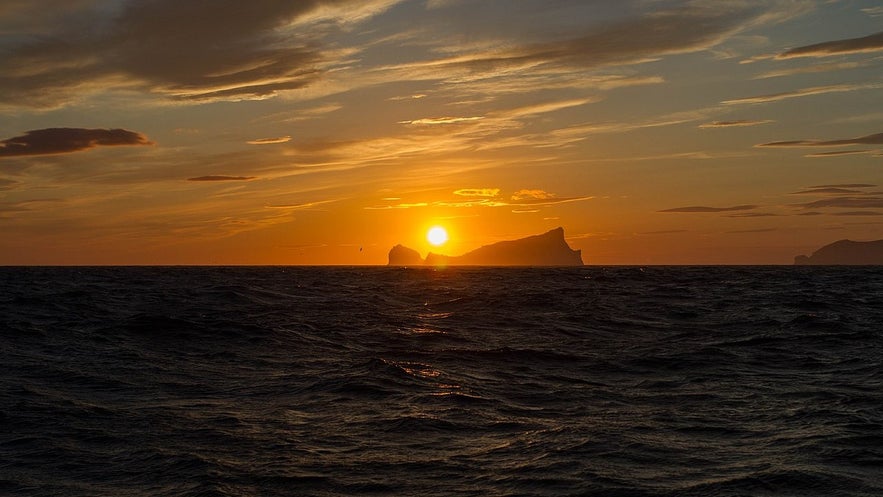
Photo from Wikimedia, Creative Commons, by voilier.evidence.
Your experience of the Westman Islands will vary depending on what time of year you're visiting, with each season providing different pros and cons.
Unsurprisingly, summer is the most popular time for visiting the Vestmannaeyjar archipelago. The mild temperatures and 24-hour sunlight hours allow visitors to explore the scenic beauty at its best, with the soft glow from the midnight sun providing great photo opportunities. This is also the best time to see puffins, as it's the height of the nesting season!
Spring and fall also make for good times to visit as you'll can still comfortably explore, and you'll have a quieter experience as there are fewer visitors. As long as you prepare for the cooler temperatures by dressing warmly, you can still enjoy what the islands have to offer. However, be aware that weather can shift quickly during this time, so keep your plans flexible to account for this unpredictability.
Visiting in winter is the least popular due to cold weather and limited daylight. However, if you decide to go for it, you can experience the islands under a blanket of snow, creating a magical ambiance. Northern lights sightings can be a bonus, but boat transfers might be limited due to rough seas.
In essence, each season offers its charm, but summer emerges as the favorite choice for most visitors.
Where to Stay in the Westman Islands
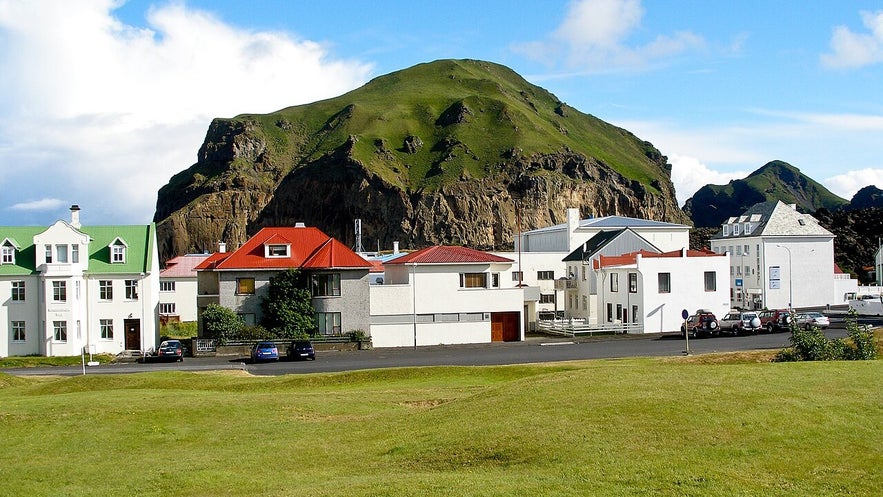
Photo from Wikimedia, Creative Commons, by Thomas Quine.
Staying a night or two in the Westman Islands will let you enjoy all that the islands have to offer. You'll find a range of accommodation options on Heimaey that cater to different tastes and budgets, so you're sure to find something to suit your needs.
The best hotel in the Westman Islands is the Hotel Vestmannaeyjar, which has an average rating of 4.6 out of 5 stars from over 120 guests. It's centrally located and offers modern rooms, with the added benefit of access to hot tubs and a sauna.
If you're looking for a budget-friendly place to stay, then the recently opened Puffin Nest Capsule Hostel is a great choice. With an average rating of 4 out of 5 stars from over 20 visitors, you'll have access to all necessities, along with a shared kitchen and lounge, for a reasonable price.
No matter your choice, you'll have a comfortable stay while being able to explore the Westman Islands from a convenient base.
What to Pack For the Westman Islands
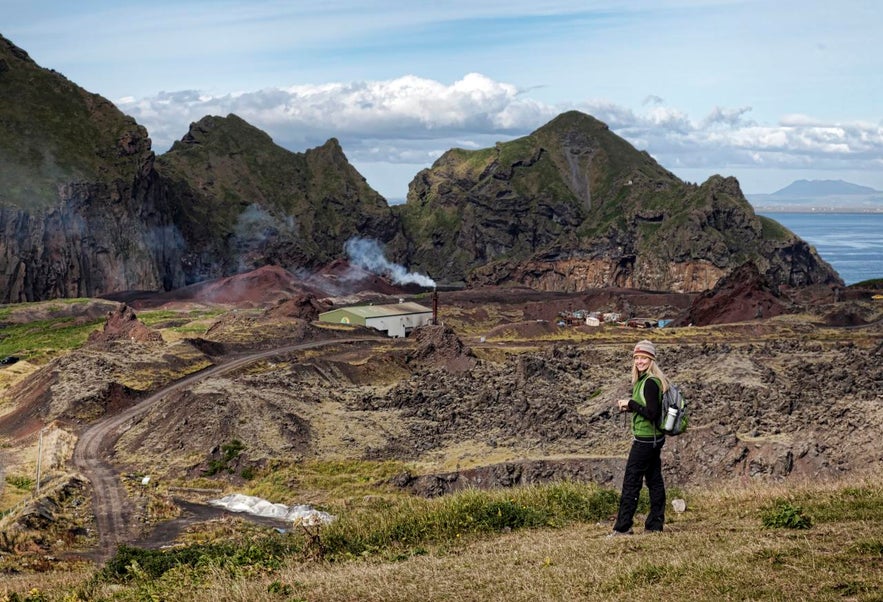
Photo from Wikimedia, Creative Commons, by Christopher Michel.
The Westman Islands have a temperate maritime climate, characterized by relatively mild temperatures. Weather is often unpredictable, with frequent rain and ever-present sea breezes. Temperatures in summer generally hover around 50°F - 59°F (10°C - 15°C), while winters remain around freezing, averaging 28.4°F - 39.2°F (-2°C to 4°C).
Wind can be particularly strong, given the islands' exposed position, and the Storhofdi peninsula of Heimaey is even referred to as one of the windiest places in Europe. This means that you should prioritize layers when packing for the Westman Islands.
Start with moisture-wicking base layers to keep dry, add insulating mid-layers like fleece or light down jackets, and finish with a waterproof and windproof outer layer. Footwear should be sturdy, waterproof, and suitable for walking on uneven terrains, as the islands boast various hiking trails.
Don't forget a hat, gloves, and scarves, even in summer, as the winds can be chilly. Pack essentials like sunglasses, sunscreen, a reusable water bottle, and a daypack. The weather can be unpredictable, so always check the weather forecast before your trip.
- See more: What To Pack for Iceland for All Seasons
The Many Islands of the Vestmannaeyjar Archipelago
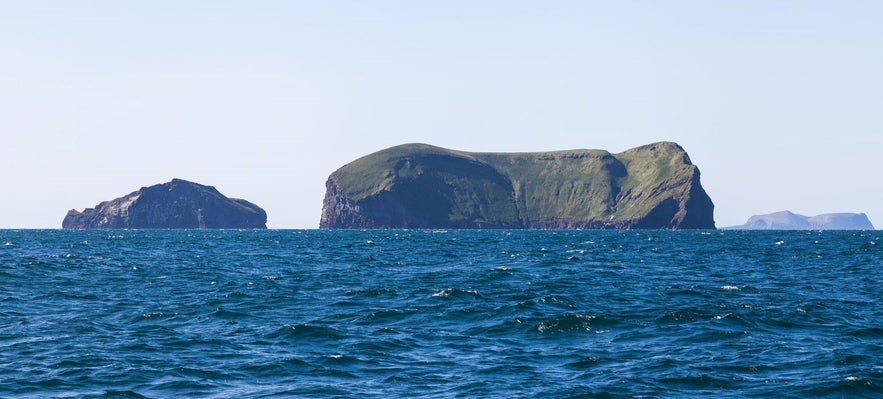
Photo from Wikimedia, Creative Commons, by Diego Delso. Brandur to the left, Alsey in the center, and Surtsey in the background to the right.
While Heimaey tends to get most of the attention as the largest and only inhabited island of the Westman Islands, the archipelago consists of 14 other islands, along with multiple skerries and rocks. They have their own distinct characteristics and charm, though most can only be appreciated from afar. To the northeast of Heimaey, you'll find Ellidaey and Bjarnarey. They're known for their dramatic sharp looking cliffs, with lone hunting cabins among grassy fields. For years, there has been an ongoing misconception that the singer Bjork lives in the lonely house on Ellidaey, but in truth, the lodge is actually used by locals for puffin hunting.
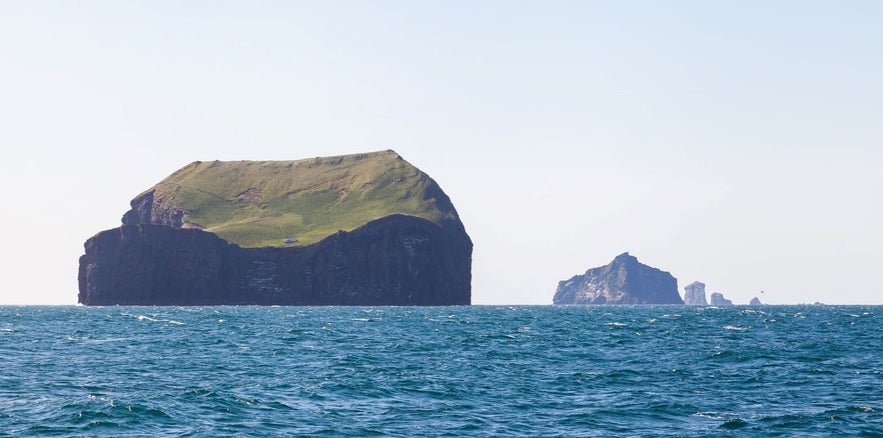
Photo from Wikimedia, Creative Commons, by Diego Delso. From left to right, Sudurey, Hellisey, and Geldungur in the background. Sulnasker is behind Hellisey.
Alsey, Sudurey, and Brandur are other notable islands in the archipelago, located to the southwest of Heimaey. They're used for puffin hunting, though sheep also graze on the islands. The nearby Hellisey is known for being very hard to access.
Another remarkable island is Sulnasker, which is characterized by dramatic rock pillars or "súlur" in Icelandic and for having a large population of northern gannets, coincidentally also called "súlur" in Icelandic. Additionally, you'll likely spot the islands of Geldungur and Geirfuglasker, which are much smaller in size but are important habitats for seabirds. The same applies to the Smaeyjar, a group of four small islands and skerries just to the east of Heimaey.
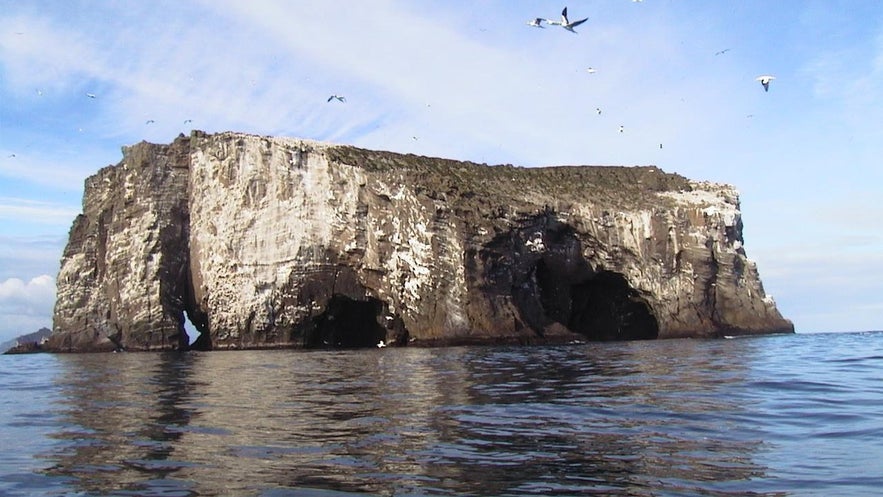
Photo from Heimaslod, Creative Commons, by Frosti Gíslason. The rock pillars of Sulnasker.
Out of all the islands, the most unique is Surtsey. It's the youngest of the group, emerging from the sea in 1963 following a volcanic eruption. Its untouched ecosystem is a UNESCO World Heritage Site and it serves as an invaluable location for the scientific study of how life establishes itself on new land. It can not be visited by the general public, but you may see it from a distance during a boat tour.
You'll see many other small skerries and rocks breaking the waves of the ocean, each one presenting a different facet of the archipelago's rich geological history. Some of the most striking ones are the Thridrangar sea stacks. They serve as a nesting ground for seabirds, but they're most famous for Thridrangarviti, possibly the loneliest lighthouse in the world. You won't be able to visit as it's only reachable by helicopter, but you may spot it during a boat tour of the islands.
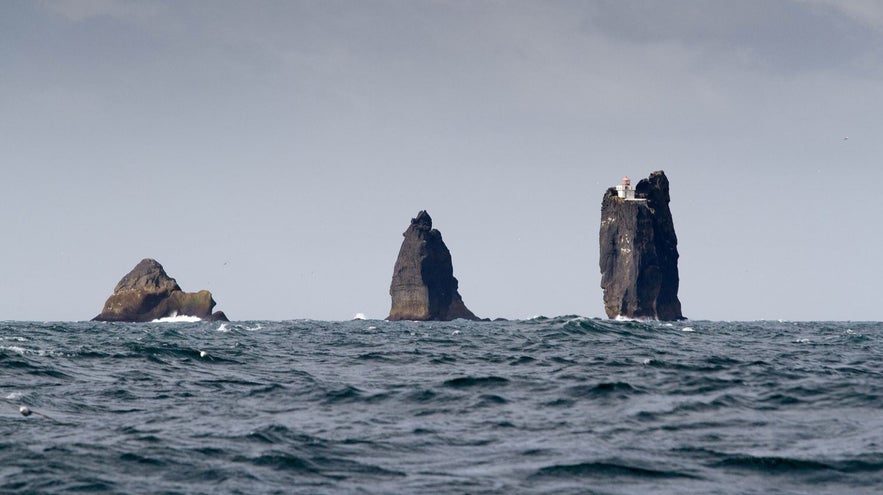
Photo from Wikimedia, Creative Commons, by Richard Tanguy.
History of the Westman Islands
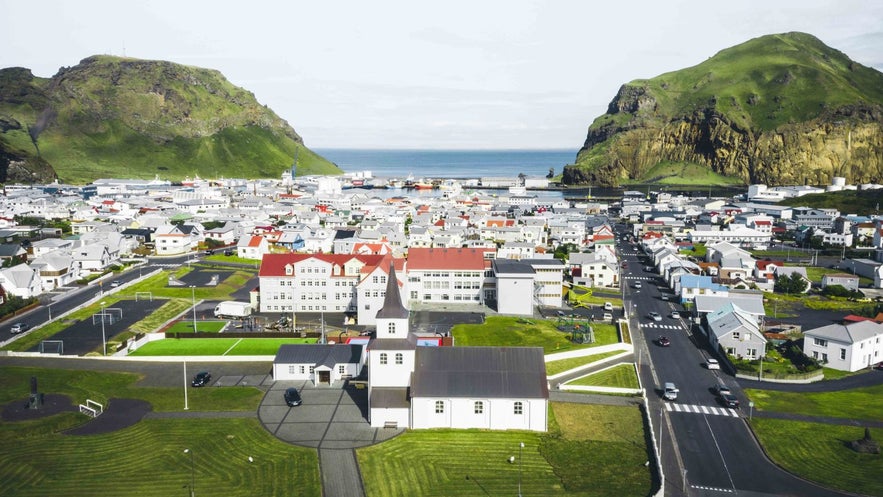 The Westman Islands bear a history as rich and dramatic as their volcanic landscape. The archipelago was formed through a series of underwater volcanic eruptions thousands of years ago, with the oldest part that's still visible above water being the Nordurklettar cliffs of Heimaey, which trace back 40.000 years.
The Westman Islands bear a history as rich and dramatic as their volcanic landscape. The archipelago was formed through a series of underwater volcanic eruptions thousands of years ago, with the oldest part that's still visible above water being the Nordurklettar cliffs of Heimaey, which trace back 40.000 years.
Through the centuries, the Westman Islands have witnessed some of Iceland's most significant historical events, each one leaving a mark on the islands, shaping its culture, landscape, and the resilient spirit of its inhabitants.
Settlement of The Westman Islands
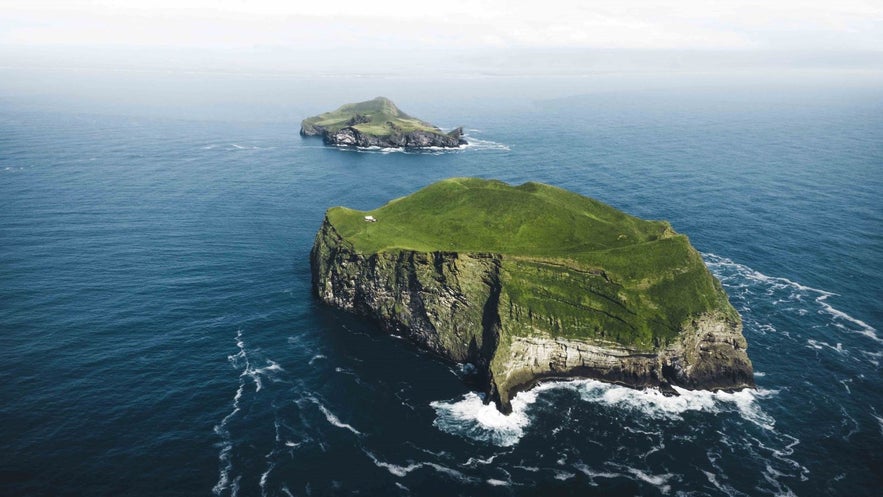 The first mention of them comes from the medieval manuscript Landnamabok which describes the settlement of Iceland. There, the origin of the name "Vestmannaeyjar" is explained in a dark story of murder and revenge.
The first mention of them comes from the medieval manuscript Landnamabok which describes the settlement of Iceland. There, the origin of the name "Vestmannaeyjar" is explained in a dark story of murder and revenge.
Brothers-in-law Ingólfur and Hjörleifur arrived in Iceland around 874 AD as the island's first Norse settlers. Ingólfur is said to have settled in the Ingolfshofdi cape to the Southeast, and Hjörleifur in the Hjorleifshofdi cape, a bit further to the South.
Shortly after setting up camp, Hjörleifur was killed by his Irish slaves (or thralls), who then fled to the islands off the south coast. However, Ingólfur and Hjörleifur were not just brothers-in-law, but they had sworn loyalty to each other by becoming blood brothers. This meant he was sworn to avenge Hjörleifur's death no matter what. This meant that as soon as he learned about his blood brother's death, he started looking for the slaves and eventually found them on the islands and killed the male slaves while freeing the women.
 Since then, the islands have been known as Vestmannaeyjar, or "the Westman Islands." This is because people from Ireland were generally referred to as "west men" by the Norse at this time because Ireland was considered the westernmost point of Europe.
Since then, the islands have been known as Vestmannaeyjar, or "the Westman Islands." This is because people from Ireland were generally referred to as "west men" by the Norse at this time because Ireland was considered the westernmost point of Europe.
The islands were likely settled sometime in the 10th century, though there are contradicting accounts of who did so first. The most popular story states that it was Herjólfur Bárðason who is said to have lived in Herjolfsdalur valley. Some archeological remains of a Viking house have since been found in the area, though they do not confirm the story. Nonetheless, Hjörleifur's house has been recreated in the valley, and you can visit it during your trip to Heimaey.
If you're traveling through the South Coast of Iceland and to the East, then remember to check out Hjorleifshofdi and Ingolfshofdi. Both offer beautiful hiking and photo opportunities, and the former is the location of the viral Yoda Cave, a unique filming location of the Rogue One: A Star Wars Story film from 2016.
The Turkish Abductions of 1627
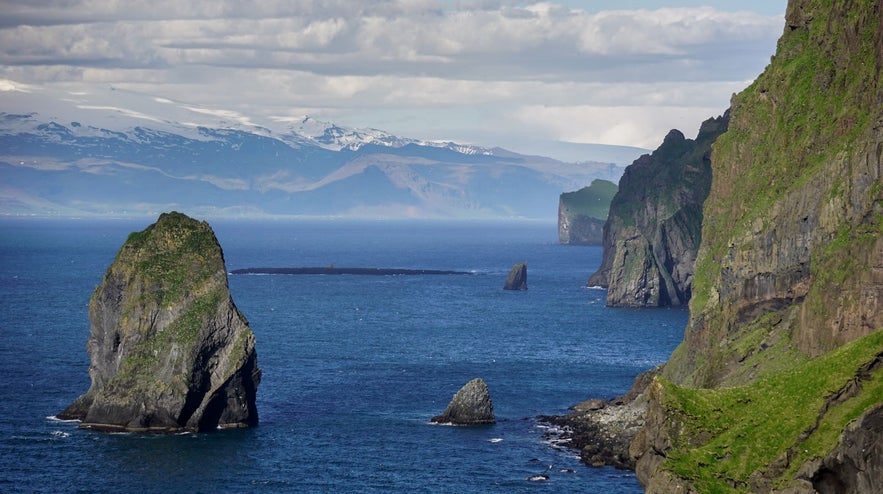
The Turkish Abductions, also known as the Turkish Raids or "Tyrkjaránið" in Icelandic, was a tragic event that took place in the year 1627 and left a large mark on the history of the Westman Islands and Iceland as a whole. Keep in mind that the term "Turk" at the time referred to all nations under the Ottoman Empire, which included modern-day Turkey, but extended to a large area around the Black Sea, parts of the Arabian peninsula, and most of North Africa.
During the summer of 1627, the tranquil life of the Westman Islands was shattered when a fleet of around 300 Barbary pirates, hailing from Algiers and Morocco, launched a series of raids on the Icelandic coast, with the Westman Islands suffering the most severe consequences.
With little means to defend themselves against the heavily armed pirates, the islands fell victim to a brutal onslaught. The pirates killed approximately 36 islanders and captured around 234, almost half the population of the Westman Islands at the time, and a total of about 400 Icelanders, selling them into slavery in Algiers.
Among the captives was a pastor named Ólafur Egilsson, who was later released to travel back to Denmark to arrange the payment of ransom for some of his fellow countrymen. While several captives were eventually ransomed and returned home years later, many others spent the rest of their lives in captivity.
Ólafur's written account provides a detailed insight into the events of the Turkish Abductions and his journey back home. His story has since been published as a book, which has recently been translated into English with the name "The Travels of Reverend Olafur Egilsson."
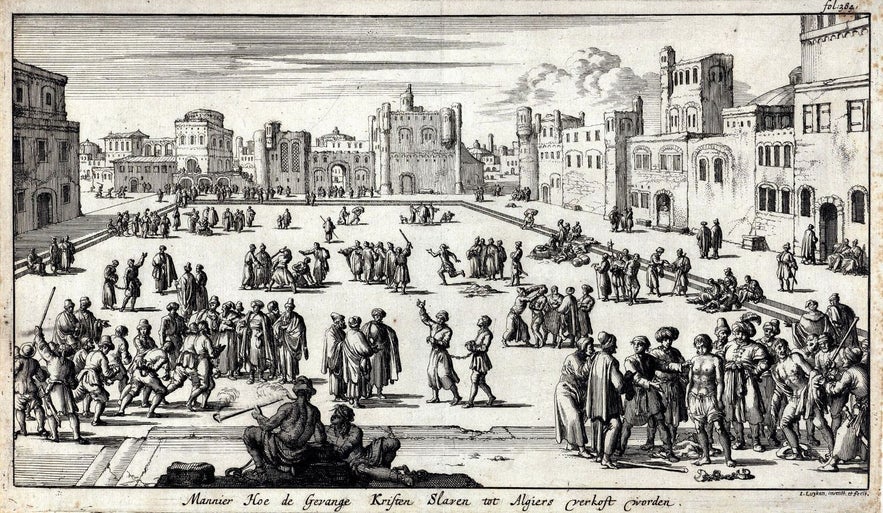
Photo from Wikimedia, Creative Commons, by Jan Luyken. A Dutch engraving from 1684 showing Christian slaves for auction in Algiers.
The Turkish Abductions left deep wounds among Icelanders. The fear of future impending attacks lived among the people for centuries afterward, with stories of the horrors being shared between generations.
An example of this can be found in the local folklore. There is a large cliff that towers over the town of Vestmannaeyjabaer, known as Hasteinn. According to local lore, it was said that if three specific things took place, it would mean the return of the pirates and a repeat of the 1627 abductions.
This would happen if the town expanded to the west past Hasteinn cliff, the freshwater source of Vilpa was blocked, and if the son of a bishop were to become a priest in the Westman Islands. By 1973, two of these had occurred, and while the pirates did not return, some connected this belief to the eruption of the Eldfell volcano in January of that year.
The same year, the third event took place as Karl Sigurbjörnsson became a priest in the Westman Islands, who happened to be the son of Sigurbjörn Einarsson, a former bishop of Iceland.
So who knows? Maybe the story was true, and these events were pre-determined, and nature was simply too quick on her feet...
The Eldfell Eruption of 1973
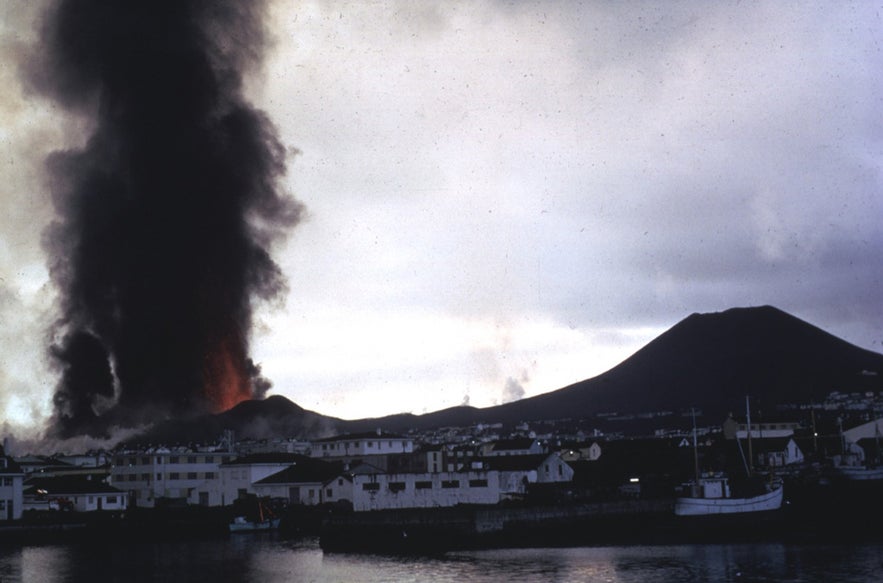
Photo from Wikimedia, Creative Commons, by Tom Simkin.
One of the most significant events in Iceland's recent history is the eruption of the Eldfell volcano on Heimaey Island. The eruption, which started on January 23, 1973, was a dramatic event that had a profound impact on the island and its inhabitants. It lasted for around six months, finally coming to an end on July 3rd.
On the fateful night, a fissure opened on the eastern side of the island, close to the town. Lava fountains erupted into the sky, and within hours, lava and ash were raining down on the town. The eruption was completely unexpected; there had been no seismic activity to warn of the impending disaster, and before this, it was believed that all volcanic activity on the island was inactive.

Photo from Wikimedia, Creative Commons, by Christian Bickel fingalo.
The island's residents were awakened in the middle of the night by the police and the sound of the volcano's thunderous roar. Remarkably, a fishing fleet was in the harbor due to bad weather, and the boats were instrumental in evacuating the island's population. All 5,000 inhabitants were evacuated to the mainland, and miraculously, only one life was lost following the event.
The eruption continued for nearly six months, burying homes and buildings under lava and ash and drastically changing the island's landscape. The lava flow threatened to close off the harbor, which was the lifeblood of the island's economy. Ingeniously, islanders pumped seawater onto the advancing lava to cool and slow its progress, successfully saving the harbor.

Photo from Wikimedia, Creative Commons, by Christian Bickel fingalo.
After the eruption ended, the process of cleaning up and rebuilding began. Two-thirds of the island's population returned to rebuild their homes and lives, demonstrating remarkable resilience.
Of the 1350 houses on the island at the time, 417 went under the lava, and many more were significantly damaged. You can see some of them today, and some houses have even been preserved at the Eldheimar Museum, where you can learn more about this dramatic event.
Today, the landscape bears the scars of the eruption, and Eldfell stands as a poignant reminder of the island's fiery past.
Part of why the eruption was so unexpected was that the technology used at the time simply was not advanced enough. Seismologists have determined that if current technology had been available, locals would have known 30 hours ahead of time about the impending eruption.
This means that if another eruption were to take place in the Westman Islands, it will not catch locals by surprise.
Traditions in the Westman Islands
The locals of the Westman Islands have some distinctive cultural events and traditions that differ from the mainland. Here are some things to know before you go.
Thjodhatid
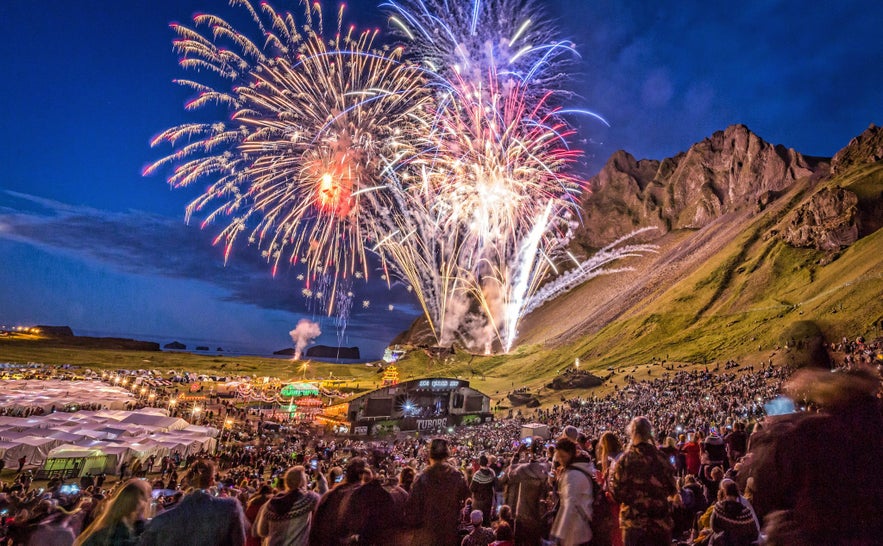
Photo from Þjóðhátíð í Eyjum.
The National Festival, or "Þjóðhátíð" in Icelandic, is an annual festival celebrated in Herjolfsdalur valley in the Westman Islands. It's one of the biggest events on the Icelandic cultural calendar, with thousands flocking to the islands each year.
Thjodhatid always takes place during the first weekend of August. It's known as Merchants Weekend, as the following Monday is a public holiday, known as Commerce Day. On these days, you'll find more festivals and celebrations all around Iceland, but Thjodhatid is by far the biggest.
Even if you're not attending any festival, be aware that there will be significantly more traffic on the Ring Road, especially on Monday. Many people will also be driving hungover, so be cautious.
Know that if you visit Heimaey during the first weekend of August, you will have a very different experience than when visiting any other time. The town will be filled with people, some renting hotel rooms and apartments, but most are camping. You'll also find events intended for families with children during the day, and during the night, a lot of people will be partying.
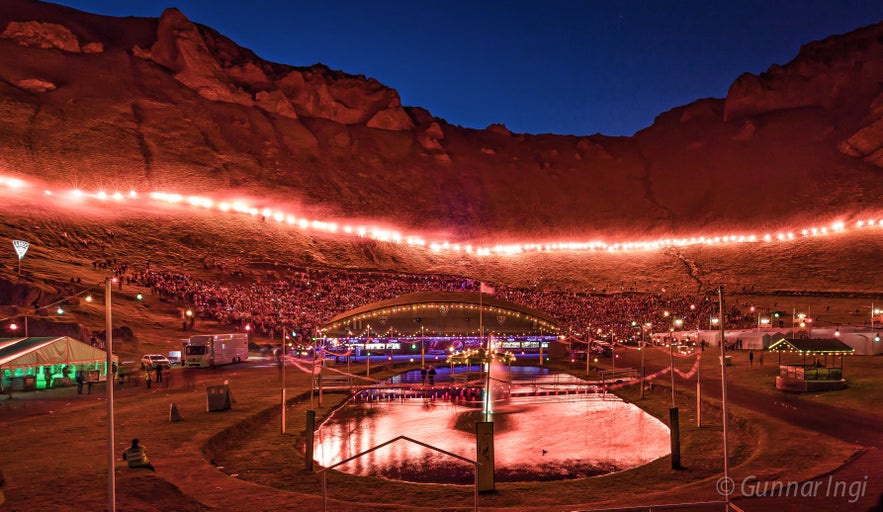
Photo by Gunnar Ingi Gíslason from Þjóðhátíð í Eyjum.
The history of Thjodhatid traces back to 1874 when the nation celebrated the thousand-year anniversary of Iceland's settlement, and they received their first constitution from Christian IX of Denmark. In the Westman Islands, this celebration took place in Herjolfsdalur valley.
It's not known if this is because they couldn't make it to the mainland because of bad weather or if they simply wanted their own celebrations, but by the turn of the century, the festival had become a tradition. It has been held almost every year since 1901.
If you do decide to attend the Thjodhatid, the celebrations span three days and nights, from Friday morning to Sunday night. You'll have a great time enjoying bonfires, fireworks, live music, and festivities among the locals.
One of the highlights of the weekend is when torches are lit on Herjolfsdalur valley's slopes, creating a mesmerizing sea of light under the midnight sky. Below, the attendees sing and party together through the night.
Whether you partake in the wild nightly parties or enjoy the family-friendly daytime events, Thjodhatid offers an unfiltered glimpse into Icelandic culture. It's a celebration loved by many, embodying a sense of community and tradition that lingers long after the last torch has burned out.
Goslokahatid

Photo from Goslokahátíð í Vestmannaeyjum.
Goslokahatid, which translates directly to "End of Eruption Festival," is a yearly event in the Westman Islands. It commemorates the end of the 1973 Eldfell volcanic eruption that profoundly impacted the island community, and generally takes place over seven days in the beginning of July.
Activities during Goslokahatid include guided walks around the volcanic site, exhibitions showcasing art and photographs, and communal gatherings with music and dance. You'll also find special events in the island's museums. While most of these will go on in Icelandic, there will be events that visitors can enjoy, along with the celebratory atmosphere.
It's the second-largest festival in the Westman Islands and serves as a powerful reminder of the delicate balance between humans and nature and the enduring spirit of the Westman Islander community.
Puffin Hunting and Egg Picking
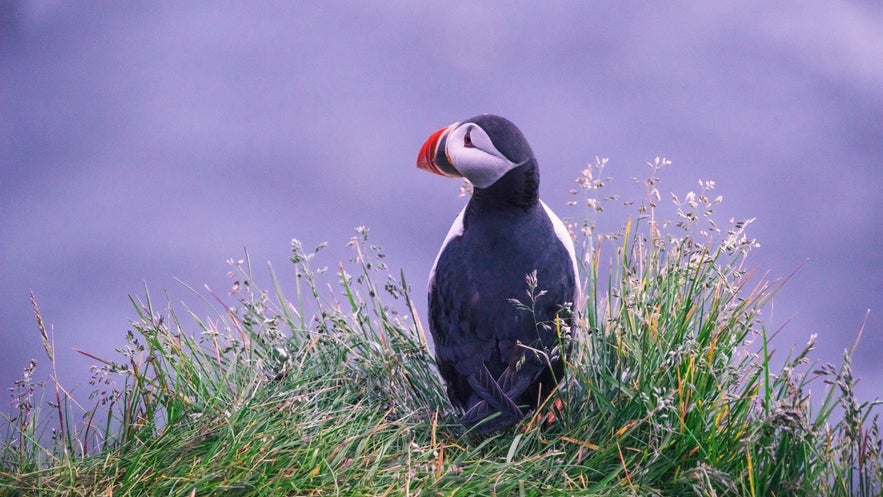 Puffin hunting is a centuries-old tradition in the Westman Islands, Iceland. These islands house the world's largest Atlantic puffin colonies. Locals used to catch puffins mainly for sustenance. Additionally, egg-picking on steep cliffs has been done through the centuries
Puffin hunting is a centuries-old tradition in the Westman Islands, Iceland. These islands house the world's largest Atlantic puffin colonies. Locals used to catch puffins mainly for sustenance. Additionally, egg-picking on steep cliffs has been done through the centuries
Today, however, it's mostly a sport, using techniques passed down through generations. The most historic method is "sky fishing," where hunters use a long-handled net to catch puffins in flight.
However, with declining puffin numbers in recent years, there have been growing conservation concerns. As a result, hunting quotas have been implemented, and some years see a total ban on puffin hunting to allow populations to recover.
If you want to try puffin meat, you can some restaurants serving it around Iceland.
- Explore further: The Best Restaurants in Reykjavik
The Puffling Patrol
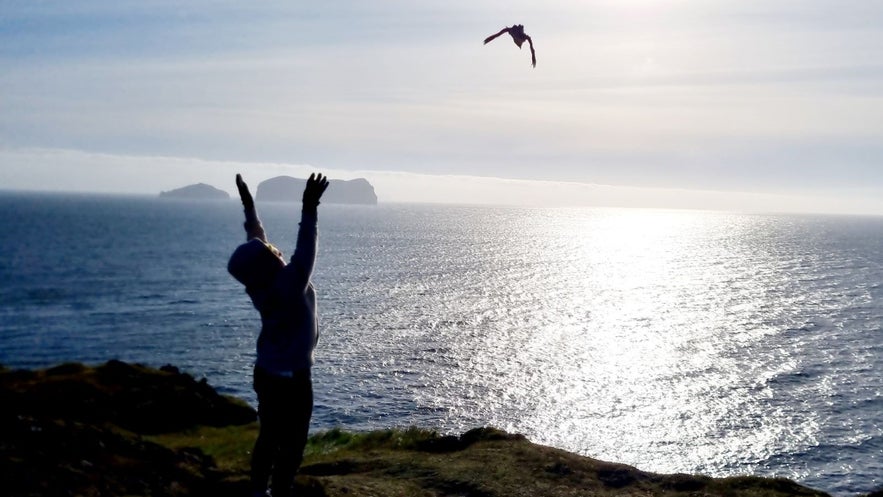
Photo from the Pysjueftirlitið or Puffling Patrol.
The Puffling Patrol is a heartwarming tradition in the Westman Islands, where locals, especially children, rescue baby puffins, or "pysjur" in Icelandic, that have gotten disoriented by the town's lights during their maiden flights to the sea.
Each autumn, as pufflings leave their nests, some inadvertently fly inland. Children, equipped with flashlights, boxes, and gloves, scour the streets long past their bedtime, seeking and collecting these lost birds. Once found, the pufflings are kept overnight and then released the next morning at the shore, ensuring a safe journey to the sea.
This community-driven initiative highlights a profound connection between the island's residents and their feathery neighbors.
Spranga - Cliff Swinging
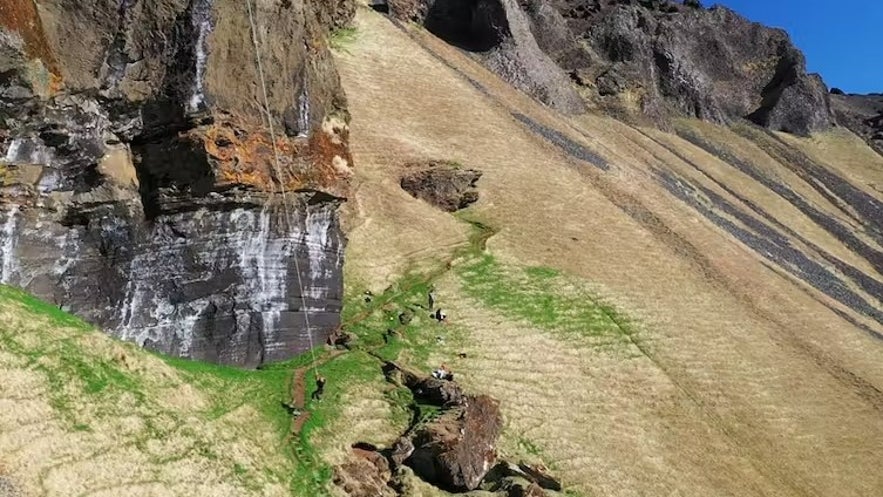
Photo from the Spectacular 4-Hour Clifftop Hiking & Boat Tour on the Westman Islands.
Spranga is a unique and exhilarating cliff-swinging activity and the local sport of Heimaey. It's part of a centuries-old tradition where locals would scale the steep island cliffs with ropes to collect bird eggs, though today, it has mostly evolved into a recreational adventure for both locals and visitors.
In the past, locals would train in the art before attempting to take on the dangerous ocean cliffs, with the most popular training location being Sprangan rock. There, you can try your hand at the sport, though this is most safely done with help from a guide or a local.
You can also experience Spranga cliff swinging as part of your exploration of the Westman Islands, with this spectacular 4-hour clifftop hiking and boat tour. You'll have help from a guide as you swing from the Saltaberg rock, before embarking on further adventure.
For a better idea of how the sport works, watch the video below, where you can see a professional practicing Spranga.
Summary of the Westman Islands
The Westman Islands, with their captivating landscapes and vibrant cultural heritage, remain one of Iceland's most alluring destinations. Whether it's the haunting beauty of the volcanic terrains, the sight of delightful puffins, or the local community and culture, the islands offer something unique to every visitor.
A trip to these islands offers a brush with history and a true Icelandic adventure. Those who venture to this often-overlooked gem leave with a richer understanding of the delicate harmony between nature and mankind.
Which locations would you like to see in the Westman Islands? Would you try your hand at Spranga? Are there any locations we missed? Share your thoughts in the comments below!
Weitere interessante Artikel
Top 13 Aktivitäten in Akureyri (und Umgebung)
Entdecke die 13 besten Dinge, die du in Akureyri und Umgebung unternehmen kannst. Islands „Hauptstadt des Nordens“ ist das Tor zu einigen der schönsten und einzigartigsten Erlebnisse in Island, z.B. z...Weiterlesen
VIP Club von Guide to Iceland: Ein umfassender Guide
Als Kunde von Guide to Iceland hast du nicht nur Zugang zur größten Auswahl an Touren, Unterkünften und Mietwagen in Island, sondern auch zu tollen Rabatten und Sonderangeboten in verschiedenen Einr...Weiterlesen
Kleidungstipps für Island: Der ultimative Guide für alle Jahreszeiten
Island ist berühmt-berüchtigt für sein wechselhaftes Wetter mit milden Wintern und oft kühlen und windigen Sommern. Die richtige Kleidung für ein Land mit launischen Wettergöttern zu finden, kann eine...Weiterlesen

Lade Islands größten Reisemarktplatz auf dein Handy herunter, um deine gesamte Reise an einem Ort zu verwalten
Scanne diesen QR-Code mit der Kamera deines Handys und klicke auf den angezeigten Link, um Islands größten Reisemarktplatz in deine Tasche zu laden. Füge deine Telefonnummer oder E-Mail-Adresse hinzu, um eine SMS oder E-Mail mit dem Download-Link zu erhalten.




















